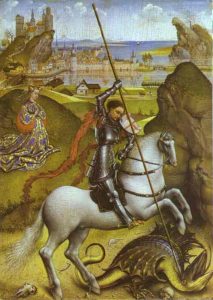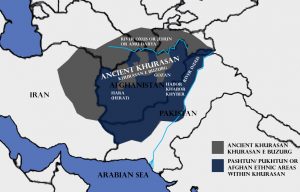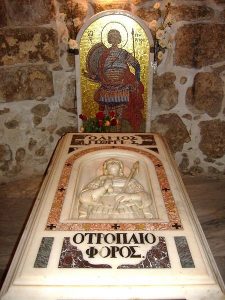 Recently I was curious enough to learn what today’s Muslim teachings about the “end times” were to pick up and read two books:
Recently I was curious enough to learn what today’s Muslim teachings about the “end times” were to pick up and read two books:
- Apocalypse in Islam (2011) by Jean-Pierre Filiu (translated by M. B. DeBevoise)
- Holiest Wars: Islamic Mahdis, Their Jihads, and Osama bin Laden (2005) by Timothy R. Furnish.
 Filiu’s work is by far to be preferred for anyone wanting a more complete overview. The 2005 publication has its strengths — I was fascinated by the historical accounts of the various Mahdist movements, in particular the nineteenth century Mahdi of the Sudan of Gordon of Khartoum fame — but it does lose some credibility with its clearly failed analysis of modern extremist Islamist movements, in particular with respect to the questions it was raising in relation to Osama bin Laden. Furnish is determined to focus on Sunni Muslim movements in order to “balance” the much vaster literature on Mahdism among the Shia Muslims. (The Shia dominate Iran but are also significant forces in Lebanon-Syria and parts of Iraq.) That’s a key reason Filiu’s book is to be preferred by anyone interested in Muslim end times teachings more generally.
Filiu’s work is by far to be preferred for anyone wanting a more complete overview. The 2005 publication has its strengths — I was fascinated by the historical accounts of the various Mahdist movements, in particular the nineteenth century Mahdi of the Sudan of Gordon of Khartoum fame — but it does lose some credibility with its clearly failed analysis of modern extremist Islamist movements, in particular with respect to the questions it was raising in relation to Osama bin Laden. Furnish is determined to focus on Sunni Muslim movements in order to “balance” the much vaster literature on Mahdism among the Shia Muslims. (The Shia dominate Iran but are also significant forces in Lebanon-Syria and parts of Iraq.) That’s a key reason Filiu’s book is to be preferred by anyone interested in Muslim end times teachings more generally.
A reassuring message that comes through is just how unimportant are teachings about last days and end time apocalypse in the political and everyday thinking of Muslims generally. As among Christians (and my impression is that even more-so than among North American Christians) the overwhelming majority of Islamic teachers and general body of believers tend to look down upon minorities in their midst who get too carried away with apocalyptic speculations. Both books were published before Islamic State burst on the scene in 2014 but little that I have read about IS changes this overall balance of interest.
Of interest to me were the sources of the various apocalyptic beliefs. Comparable Christian beliefs are taken from canonical sources like the books of Revelation and Daniel. These are generally interpreted through the dispensationalist concepts originating with the Scofield Reference Bible. Add a touch of Hal Lindsay and maybe a little Nostradamus for the most extreme and that’s basically it. Islamic apocalypticism is more eclectic by spades. Much of it even draws upon the Christian sources just mentioned! There are Islamic texts, certain hadiths, that do form the basis of Muslim apocalyptic but they are relatively light on with respect to details and narrative flow.
As for dates, 1979 was a turning point for the Islamic world.
- the seizure of the grand mosque in Mecca by a group of messianic extremists,
- the invasion of Muslim Afghanistan by the Soviets
- and the Iranian revolution.
For the significance of 1979 compare Jason Burke’s analysis of the rise of global Islamic militancy. Two Vridar posts discussing Burke’s explanation:
- The Origins of Islamic Militancy and
- So why did militants turn to attack the West? — The Saudi Arabia driver

The triple shocks of 1979 were a turning point although various clear ideas of what to make of these events did not coalesce overnight. This period was the beginning of the fifteenth Muslim century and nothing eschatalogical had been foretold of this period so it took a little while to reinterpret and understand anew various prophecies. Afghanistan and Iran may look remote to Christians but they are the centre of Khurasan, a “mythical land” long associated with Afghanistan and where the Messiah’s appearance was foretold.
I could not fail to be interested in various prophetic views of Jesus. They vary from Jesus returning to condemn everyone who failed to convert to Islam to Jesus inspiring a special tolerance and place for Christians. Another reminder that the Muslim religion is anything but a monolith.
Some of the predictions involving Jesus
First comes the Antichrist to the land of Sham, or Syria. Other prophecies locate him in Khurasan.
Allah will then send Jesus, the Messiah and Son of Mary, from heaven. His landing pad will be “the white minaret on the east side of Damascus”. Jesus will then hunt down the Antichrist till he finds him at “Ludd” (=Lod in Palestine). (Why he doesn’t just go straight to Lod to ambush the Antichrist is not made clear.) When he destroys the Antichrist at Lod he will also wipe out all the Antichrist’s Jewish followers who had refused to become Muslims. Jesus will then comfort the surviving Muslims and take them to a safe refuge on a mountain that is widely interpreted as the Mount of Olives. (Others think it is Mount Gerizim, or Mount Sinai…) This “place of safety” will protect the faithful from the hordes of Gog and Magog (a Turkic race, also Persians, according to some) who will then overrun the landscape and surround Jesus and his true Muslim followers. Jesus will then again pray to Allah who will smite those hordes with poisonous insects (another prophecy has Allah killing them with “a worm in the neck”) and then have their putrid bodies carried away by camel-necked birds.
More hopeful to some extent for surviving Christians is one prophecy that says Jesus at this time (after destroying all crosses and swine) will convert them to the Muslim faith so they, too, can live happily ever after.
Both Sufi mystic eschatologically minded Muslims and various Western-based Muslims teach an almost ecumenical role for Jesus. The returned Jesus will make the Mahdi his subordinate much like Aaron was subordinate to Moses, and he will shock fundamentalist Muslims as much as anyone else with his more tolerant and accepting approach to Christians. Christians are still wrong, of course, but so are dogmatic Muslims, so these Muslim apocalypticists believe that today we are witnessing Westerners converting in large numbers to Islam and generating a faith that respects the less dogmatic versions of both Christianity and Islam.
Another teacher identifies the apostle Paul as the original agent of the Antichrist. It was Paul who led Jesus’s followers astray by falsely declaring him to be the Son of God etc. and who led to that strain of teaching that produced emperor Constantine and the Crusades in the service of the Jews.
One more thing
The expectation that Jesus will destroy the Antichrist at Lod strongly appears to have derived from the legend of Saint George the dragon slayer. Saint George is said to be buried at Lod and from the days of Constantine a cult grew up around him in Lod.

If you enjoyed this post, please consider donating to Vridar. Thanks!

Mr. Godfrey,
Thanks for taking time to read, and write about, my book from 2005. But perhaps your saying that Filiu’s book is preferable might be because you are looking for explication of The End in Islamic thought, whereas my book is primarily a historical study of Sunni men who claimed to be the Mahdi, and the movements they created.
I can take a good critique; but please, base such on the book I wrote, not the one you wanted me to write.
I might point out that my prediction of more such movements arising in the Sunni world has proved true, with ISIS.
Timothy R. Furnish